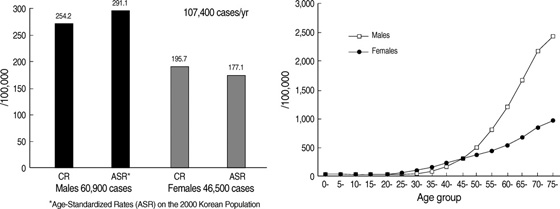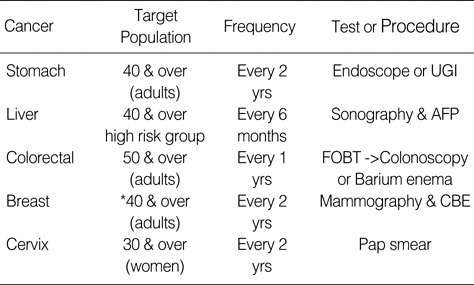Overview
Every year, approximately 110,000 people are diagnosed with cancer in Korea while 64,000 die of it. Cancer became the first leading cause of death in Korea in 1983. Cancer mortality has been steadily increasing over the last two decades and cancer deaths accounted for 26.7% of all deaths (65,505/245,771) in 2004, which means that one in every four Koreans becomes a victim of this life-threatening disease.
Stomach, lung, liver, and colorectum are the four most common primary sites of cancer in Korean men, accounting for almost two-thirds of all cancer burden. Stomach, breast, colorectal, cervix, lung, and liver cancers constitute two-thirds of the total cancers in Korean women.
In contrast to the relatively low cancer incidence reported in Globocan 2002, the overall age-standardized incidence rates (ASR) in Korean men are now higher than the world averages and are similar to those reported in northern Europe. However, Korean women still overall ASR similar to the world average and lower than those reported in Europe. In both sexes, ASRs of stomach, colon and rectum, liver, lung and thyroid cancers are higher than the world averages.
Considering the magnitude of the rising incidence (annually 100,236 cases during 1999-2001) and mortality, cancer is currently one of the most pressing public health problems facing Korea, and the ageing of the Korean population will cause these numbers to continue to increase even if age-specific rates remain constant.
Cancer Control Policy in Korea
In response to the growing cancer burden at the government level, the Cancer Control Division was built within the Bureau of Health Promotion, the Ministry of Health & Welfare in 2000. Also, the National Cancer Center was founded in March 2000 as a government-funded institution devoted to research, patient care, education & training in cancer. The Cancer Control Act, another important legal framework for controlling cancer in Korea, was legislated in 2003. This law authorizes the Health & Welfare Minister to formulate and implement cancer control programs and promote international collaboration as well. In early 2006, the comprehensive second-term cancer control plan for the next ten years (2006-2015) was forged to strengthen the cancer control efforts at the government level within the following framework:

<Scheme of the Government's 2nd-term 10-yr Plan for Cancer Control>
Major Cancer Control Programs
National R&D Program for Cancer Control
From 1996 the National Cancer Control Planning Board supports R&D activities of industry, academia and research institutes by providing them with grants. It finances a wide range of cancer topics from basic, translational to clinical research.
National Cancer Registration Program
Started as Korea Central Cancer Registry (KCCR) in 1980, this program registers detailed information on cancer cases from more than 150 training hospitals across the country every year. It also supports the regional cancer registries technically and financially. KCCH publishes a national cancer incidence by collecting and analyzing the hospital-registered data.

<Cancer Incidence in Korea 1999-2002>
National Cancer Screening Program
Implemented by Supporting Committee for Cancer Screening Program from 1999, the Program provides targeted population with free screening services for five common cancers-stomach, liver, colorectum, breast, and cervix uteri.
<Guideline of NCSP>

Cancer Patients Management Programs
Program 1: A variety of medical care services are provided to low-income cancer patients free of charge by health care providers in the public health centers from 2004. The services include consultations and pain control.
Program 2: A terminal cancer patient care initiative was introduced in 2005 to help palliative care units improve the quality of palliative care.
Regional Cancer Center Support Program
This was designed to reduce regional disparity in cancer care in 2004 by designating hospitals in the provinces as Regional Cancer Centers (RRCs). The government supports each RRC to help it to strengthen its cancer care infrastructure.
Financial Aid Program for Cancer Patients
Started with leukemia patients under 18 in 2002 this financial support program aims to relieve low-income patent's financial burden.
Future Directions
Korea is planning to strengthen international exchange in cancer control, contributing to the enhancement of all the people's health around the world by sharing our knowhow and experiences accumulated over the last two decades.
In order to achieve the best outcomes in cancer control at the regional level, the current national cancer control programs should be tailored to special needs of each local community. Such customized programs should be made more effective if implemented first as a demonstration project in a selected local area.




 PDF
PDF ePub
ePub Citation
Citation Print
Print


 XML Download
XML Download